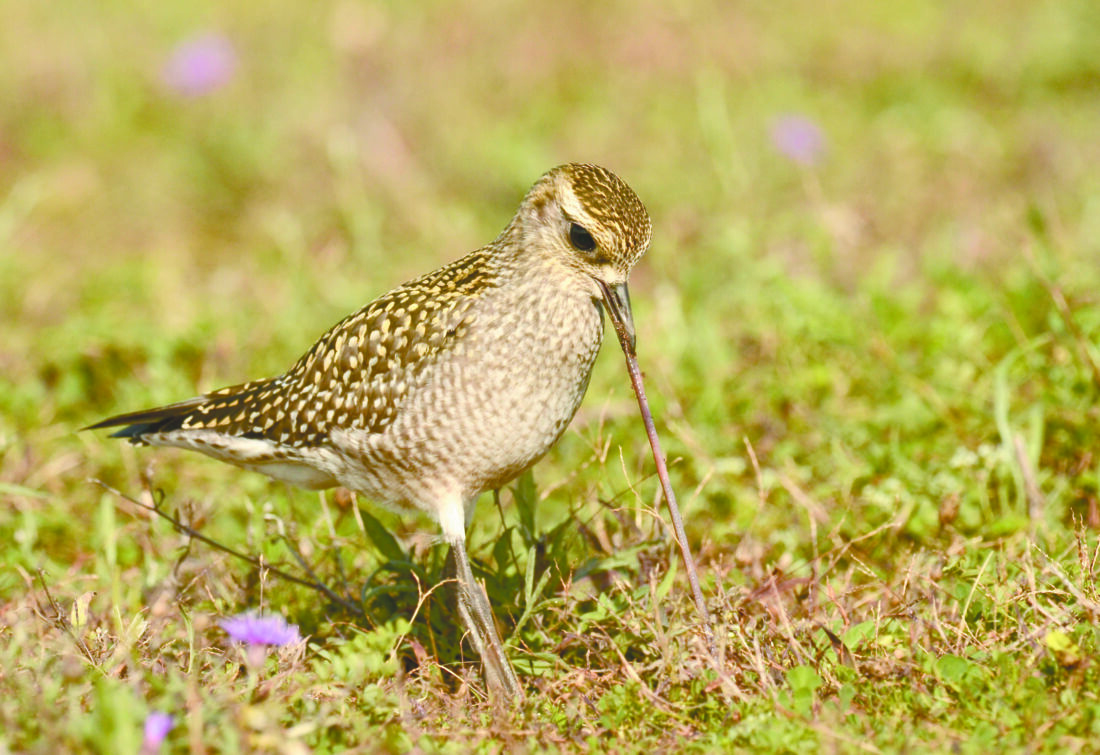Birding: Are feathered friends heading south?

Pictured is an American golden-plover. (Scot Stewart photo)
“And then the sun took a step back, the leaves lulled themselves to sleep, and autumn awakened.”
– Raquel Franco
Migrating birds flying through 50oF temperatures may feel it is the right time to be heading south, with the weather clearly saying autumn. Flying over swamps and bogs across the Upper Peninsula and in plenty of woods filled with red maple trees turning shades of bright crimson and vermillion will be convinced it must be the right time to go.
Birders visiting Presque Isle Park last Monday morning noted one of the largest migration movements in the U.P. this fall. In an eBird submission they noted observing 1,946 birds representing 52 species in flight most “leaving the island in morning flight”. Seen in the flight were 21 different species of warblers including 215 blackpoll warblers and 232 American redstarts as well as 686 unidentified warblers, as well as 70 red-breasted nuthatches, and 419 thrushes. Many of these songbirds probably stopped after crossing Lake Superior and were ready to resume their flights southward. Redstarts leaving from areas across the eastern U.S. and parts of southern Canada are on their way to Central and northern South America and blackpolls have left the boreal forests of Canada and Alaska for the rainforests of South America.
Whitefish Point counters continue to have similar days of high diversity too. Last Tuesday 54 species were tallied by counters at the Point’s tip including 18 warbler species that included a blue-winged warbler. It was the third record of one there, a species found farther south in summer. A lark bunting also seen, summers through the prairies from Canada to northern Texas and overwinters in Mexico and along there U.S. border. A redpoll was also among the other birds of the day. The main migration of red-necked grebes appeared to have ended last Sunday, but another big push of common terns was seen at the Point on Wednesday. Migrating dabbling ducks are also continuing to slowly build.
On a side note, those visiting the Point this year were able to see the changes a storm last fall brought to the end of Whitefish Point as several hundred yards were erased by high seas that also carried the old waterbird counter’s shack away. A slender pond along the tip frequently used by shorebirds to rest and feed is also gone unfortunately limiting the number of birds often seen there on the ground during migration. The southeast side of the Point also looks to have taken a serious beating at the hands of the waves. The amount of large tree trunks on the tip also seems to have increased. It will be interesting to see how the future wave action there reshapes the sandy shores.
Similar thoughts occur as many watch the mouth of the Dead River. With all the recent work there over the past year to direct the river’s flow directly into the lake and away from the ore dock a large sand spit and additional river edge were removed limiting foraging areas for shorebirds and other waterfowl. The reconstruction has also led to more human activity along the beach on the south side of the mouth discouraging shorebirds from staying too long on some warmer days, especially on weekends. There have been some changes to the south side of the river already though as a small hook has developed along the beach with a small shallow also developing in the arc.
Some local dabbling ducks seem to have fared well this summer. 45 wood ducks were seen at the Gwinn sewage lagoons. Earlier this month 24 were seen at the Dead River marshes just west of the river mouth. At Seney National Wildlife Refuge many of the shallower portions of the pools along the Marshland Wildlife Drive had wood ducks feeding in them. Mallards and of courses Canada have also fared well this summer in Marquette.
The interactions between various species of wildlife often create some very interesting situations. Recently Marquette city workers were called to assist a double-crested cormorant wandering along a street near Lake Superior. The bird appeared unable to fly and was picked up by a worker to get checked out. However, after it was collected the worker noticed a leech attached to the skin near the cormorant eye. Shortly after that the bird shook its head and the leech flew off, leaving the cormorant acting more naturally. It was taken down to the lake where it quietly, calmly left.
With the other coming signs of autumn near at hand, the back end of bird migration will be on its way soon. On the beaches and breakwalls black-bellied and American golden-plovers are some of the last shorebirds passing through. They should be showing up soon with the end of the sanderlings and smaller sandpipers and will dribble past through until mid-October. Off-shore, American pipits, horned larks, Lapland longspurs, and eventually snow buntings will also follow in the weeks ahead. Dark-eyed juncos and other sparrows follow and are among the last summer residents heading south. Some will stick around for a while but as they and the former group are ground feeders, most will eventually head farther south as snow begins to accumulate.


